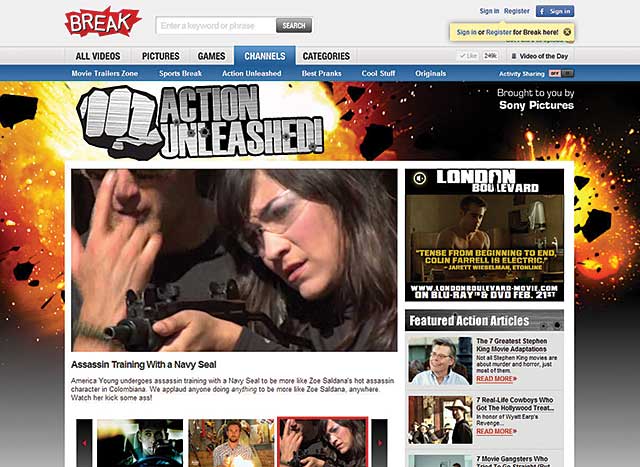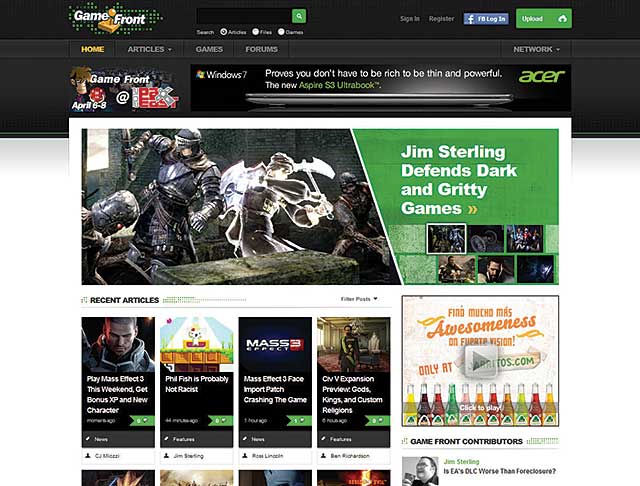Break Media Finds Big Bucks in Buffoons and Babes
Break Media owns and operates some of the web's most popular online original video sites. Their combined monthly reach exceeds 120 million visitors.
Heading the pack is Break.com; the go-to destination for people who want to see original videos such as "Box Prank Goes Horribly Wrong" and "The Amazing Boobkini." In other words, Break.com offers the best in buffoons and babes; it's not too hard to figure out that its target market is males (we won't call them men) aged 18-34.
Goofs and girls pay off: Today "Break.com is recognized by comScore as the #1 humor destination online," says Andy Tu, Break Media's SVP of marketing. "But our content scope extends beyond just humor videos," he adds. Too true: Break Media also operates Made Man, Game Front, Holy Taco, Screen Junkies, Cage Potato, All Left Turns, Chickipedia, and Tu Vez. Meanwhile, the company's Break Media Creative Lab produces original branded, celebrity, and viral videos.
So how did Break Media get here? Well, from a marketing standpoint, the company's approach combines clearly targeted, desirable content with incredible ease of access.
"Our brands all start with a strong editorial sensibility," Tu explains. "If we create and curate quality editorial content and provide users with technology that allows them to easily consume and share it across a variety of platforms, they can help us market to new users."
Next, "We have made it a major focus to leverage platforms where men are engaged including mobile, YouTube and social, extending our brand reach and giving us more opportunity to grow our properties," he says. At the same time, "We have been able to invest in higher quality editorial content by partnering with brands who are looking to marry their message with our content and audience."
Break's Background
Some history: Break Media began in 2004, when CEO Keith Richman became a fan of Big-boys.com (now rebranded as Break.com). Big-boys.com had "built a cultish following by hand-picking the best web videos every day," says Tu. Richman bought the site, "hired a technology team and an editorial staff to curate content, and created a platform that enabled users to upload their own content and share it easily with friends."
For the next 3 years, Richman built up Break.com's online audience. Then "we started to work closely with advertisers who were trying to navigate the video space, as well as target the hard-to-reach audience of men 18-34," Tu says. "Since we had little as far as standard ad solutions at the time, most of our work with our partners was completely customized to deliver on their campaign goals."

Explosions, guns, and women: Throw in some juvenile humor, and you’ve got Break.com’s formula for success.
Break Media's continuing success with Break.com motivated Richman to launch Made Man, Screen Junkies, Holy Taco, and Cage Potato. Sticking close to the company's 18-34 male demographic, these new sites "focused on verticals in which we had an editorial interest, as well as where we thought there was potential male audience," says Tu. At the same time, Break Media "created a more complete solution for advertisers with male-focused marketing efforts."
This became Break Media's formula for marketing success: Keep developing sites that attract young males, and then monetize their eyeballs to advertisers through a range of evermore sophisticated and creative ad campaigns.
Break Media's expertise was such by 2009 that when Bud Light asked it to produce a viral video, the company successfully responded with the now-legendary shot showing a hot chick nailing an incredible golf shot -- that just happened to involve a bottle of Bud. "We understood the audience and the content, which gave us the confidence that we could pick up the camera and create a video that was both entertaining and branded," says Tu. "This was our first piece of branded entertainment."
That same year, Break Media started its Creative Lab video production team. It now "includes more than 20 full time and freelance members and will create thousands of originals this year, including both branded and original video content," Tu says. "In 2010 we acquired a leading PC gaming destination then called FileFront.com and rebranded it to Game Front, broadening the focus beyond just PC files to include quality editorial coverage for the hardcore gaming audience."
Today, "Break Media is uniquely positioned at the intersection of creation and distribution of digital content," Tu tells Streaming Media. But through it all, the company has stayed tightly focused on the male 18-34 age group. The result: "Through our web properties, original content creation team and large video network, we've developed highly engaged audiences and become a partner for brands seeking to connect with the male demographic," he says.
Marketing Lessons
For streaming media marketers, Break Media's success offers some useful lessons.
First and foremost is "sticking to what you do best." Break Media understands the 18-34 male demographic and continues to build its business on it. "We listen to our audience, we deliver for our brands, and over time, we've been able to hone our skills to create original content that both brands and users gravitate towards," Tu notes.

Break Media has stayed true to its demographic while augmenting Break.com with more focused sites such as Made Man, Holy Taco, Screen Junkies, Cage Potato, and Game Front (pictured).
Lesson 2: While staying faithful to its core audience, Break Media has never stood still. The company understands that the web is constantly evolving and changing -- and that staying relevant requires constant innovation.
"We're very focused on creating new high quality original content," says Tu. "We've given Game Front a huge facelift and are working on a major redesign for Break.com, which will debut later this year. Those redesigns are focused on consumption across a wider variety of devices as well as creating a stronger platform for sharing."
Innovation also means keeping up with changes in viewing technology, such as tablets and smartphones. "Mobile now represents a significant percentage of users engaging with our brands," Tu notes. "Beyond mobile, new connected OTT devices and gaming consoles are emerging as a more lean-back, living room experience where we can engage with both current and potential users."
The third point worth noting is that Break Media is willing to take chances and to suffer losses in order to continue to succeed. "On the side of lessons learned, over the years we have explored content that hasn't always been a runaway hit, but that's how original content works," says Tu. "We get it right more often than we get it wrong."
As for the future? Break Media will continue to adjust its marketing approach to keep up with change, while remaining true to the fun-and female-loving males that are central to its success.
"We're excited about the opportunity to continue to invest in quality original video and editorial content," Tu says. "Beyond that we will continue to build our brands not just online but also across devices and platforms. Lastly, we're committed to continuing to work closely with brands to develop innovative solutions to engage our audience. Those three areas of focus are where we're spending the vast majority of our time, to ensure that we're continuing to grow in the years ahead."
[This article appears in the August/September issue of Streaming Media magazine, which will reach subscribers' mailboxes and go online as a full digital issue soon.]
Related Articles
Creating a large pool of young viewers to court advertisers, the two online video giants come together as equals.
09 Oct 2013